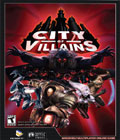Genre: MMO
Publisher: NCSoft
Developer: Cryptic Studios
Release Date: October 31, 2005
Buy 'CITY OF VILLAINS' PC CD-ROM | PC DVD-ROM
It is very difficult to accurately and fairly judge, and hence review, a Massively Multiplayer Online game with only a few weeks of play under your belt. For many fans of any given MMO, the actual playing of a game is preceded by weeks or months of intense reading and research, trawling of news sites, and posting on community forums; many gamers who choose to join an online universe on its opening day already know a great deal about the game and have made their decision to play months earlier. When I started City of Villains, I knew very little specific knowledge about this half of the Cities franchise. I am, however, a veteran of many MMOs, and I realize the limited view one can achieve when only playing a game for a few weeks, knowing that there are months of content available, if not more. It's very hard to gauge the successes and failures on such a brief experience.
Nonetheless, there are some conclusions that I can draw, based on extensive experience in the Massively Multiplayer genre, and on previous experience with City of Heroes (also somewhat limited). I think it unfortunate that many gamers who may have played City of Heroes will judge CoV unfairly based upon the reputation of it predecessor. I played CoH for several weeks and came away with what seemed to be a common opinion of the experience; it is a terrific, appealing idea, with beautifully crafted environments. The title had perhaps the single best character-generation system that was practically a game in itself, and the product as a whole was easy to learn and fun to play. However, CoH seriously lacked any significant content with little or no end game; in short, the game was boring. You can only put the beat-down on so many bad guys before it gets tedious.
Though CoV could easily be taken for an expansion to an existing game, it is in reality a game in its own right and is more of a companion title than an expansion. There are no significant upgrades in the graphics or audio department with the release of CoV. However, the game continues to compete technically, and both audio and graphics are of high caliber. Graphically, the game is still relevant, though not cutting-edge. The sound effects are appropriately comic-like and the music is quite good, while not intrusive, which is key for a game that is played for hours on end.
Now perhaps it's just me, and that deep down I crave the villainous lifestyle, but CoV was the game that I wanted to play when I was grinding my way through City of Heroes. I found the idea of rampaging through the city streets on a crime spree far more appealing than the notion of thwarting evildoers and saving the populace. Because it is a companion, with the opportunity for crossover between the two games (Player vs. Player content, raids, etc.), as well as some significant additions, City of Villains takes both games to an entirely new level. And this level is downright fun, nearly an order of magnitude above its predecessor. In fairness, this is not to say that City of Heroes is a bad game, but instead is a testament to CoV and what it offers that CoH did not.
In terms of the game mechanics, CoV is not that different from CoH. The controls are nearly identical; they are very easy to learn and use, and allow for fast-paced gameplay. The combat is fairly involved – each attack is initiated by the player, with no point-and-click fighting. Players are still led through various tasks and quests in the same manner, completing several for each of their Contacts until they are introduced to another Contact, and the cycle begins again.
There are a few significant additions to the game, however, that I highly enjoyed. This is the part where I truly expose my limited experience with City of Heroes. It is quite possible that several of the game elements I detail below were a part of CoH, but they were not introduced early enough or well enough for me to take notice of them. This is again, an indication of the strength of CoV and how well some of the redesign functions.
CoV maintains the somewhat campy, tongue-in-cheek sense of humor as City of Heroes. Many of the clichés of comic books and the genre of superheroes/archvillians are used to their full effect, but for whatever reason, I found that the jests and innuendos were much more funny when applied to villains. Humor is something terribly lacking in computer games these days – too much focus on realism, intense combat, and "serious" situations. This also carries over into a family-safe experience (or at least more so than many other games); the combat is much like older comic books, with little, if any, blood, and no gory sequences. There is still violence, but no MMO has yet been able to pull off viability without some type of conflict.
More than anything, I loved Schemes and Heists. This was not something that I had the good fortune to experience in City of Heroes, and if it was not in the original game, this is an addition that, for me, really changed the dynamics. In addition to having several Contacts throughout Mercy Island (where the game is set), I was eventually introduced to my first Broker, who arranges "profitable undertakings" for my character. The way Schemes and Heists works is that players check the local newspaper for tidbits of news and information that they can use to pull off their own Schemes. Schemes are basically side-quests, and the more Schemes you pull off, the more favor you build with your Broker. When you have impressed your Broker sufficiently, he lets you in on a bigger job – a Heist – which is a quest with a very lucrative outcome for all involved.
This addition to the game does two things. One, it gives the player some type of self-directed outlet for adventuring. The game ceases to be about completing linear quests over and over again until you are introduced to your next Contact. Lather, rinse, repeat. What Schemes to undertake are completely up to the player; they are readily available through one of the game windows, and they are quick and fun. Building up to that Heist was a lot of fun, and once I had convinced my Broker I was worthy, I eagerly jumped into the task he gave me. Two, Schemes and Heists are a break in the monotony of the game, which was something City of Heroes desperately needed. Though the tasks are very similar, if not identical in many ways, to the standard quests, they seem to have little to do with progressing to the next phase of the content. Instead, they are a way for the player to write their own story through the Schemes that they choose. It is additions like this that will make City of Villains the success story that City of Heroes was not.
Most importantly, City of Villains includes an element that truly motivates players to socialize, group, and work together on a more permanent basis – Lairs, which I consider to be both an obvious outcome of the theme of the City games, as well as a pure stroke of genius. They are areas that are owned by SuperGroups (the equivalent of guilds in many other games) and can be built and customized with a plethora of fun, evil-genius equipment, including traps, weapon systems, and henchman. The catch is that Lairs are really too expensive for an individual to realistically afford; upgrades are purchased with Prestige, a secondary form of currency that all members of a SuperGroup earn and contribute automatically to the pot. In order to make a Lair all that it should be, it is almost necessary to form a SuperGroup and work together to create and maintain them (did I mention that they also have upkeep costs?)
The positive impact affected by Lairs and the new structure of SuperGroups was immediately apparent when I started playing City of Villains. The chat channels were much more active in all areas, from SuperGroups looking for recruits to those looking to team up. I was invited (and accepted) into a SuperGroup on my second night in the game, something that never happened in the weeks that I spent in City of Heroes. To say the least, Lairs are a marvelous addition which encourage and reward socialization and cooperation within the game, as well as helping individual gamers feel a sense of place within the game world. This kind of experience cannot be overlooked.
 Though I did not get to experiment with some of the intermediate and advanced content of the game, such as Raids and Player vs. Player combat, I can only guess that they are just as triumphant. City of Villains is a tremendously successful implementation of an idea that was hatched several years ago, with the launch of City of Heroes. It seems that Cryptic and NCSoft have found a potential answer to the shortcomings that plagued their game universe. Perhaps one of the most positive things about the additions in City of Villains is that it seems that the developers have every intention to carry over the successful elements to City of Heroes, giving a good game a needed boost, and hopefully attracting new and old players to both games.
Though I did not get to experiment with some of the intermediate and advanced content of the game, such as Raids and Player vs. Player combat, I can only guess that they are just as triumphant. City of Villains is a tremendously successful implementation of an idea that was hatched several years ago, with the launch of City of Heroes. It seems that Cryptic and NCSoft have found a potential answer to the shortcomings that plagued their game universe. Perhaps one of the most positive things about the additions in City of Villains is that it seems that the developers have every intention to carry over the successful elements to City of Heroes, giving a good game a needed boost, and hopefully attracting new and old players to both games.
Score: 9.0/10
More articles about City of Villains











 City of Villains is an expansion to NCsoft's MMORPG City of Heroes, set in the Rogue Isles, a treacherous region not far from Paragon City. Players can now build their criminal empires and spread their own reign of terror.
City of Villains is an expansion to NCsoft's MMORPG City of Heroes, set in the Rogue Isles, a treacherous region not far from Paragon City. Players can now build their criminal empires and spread their own reign of terror.









































